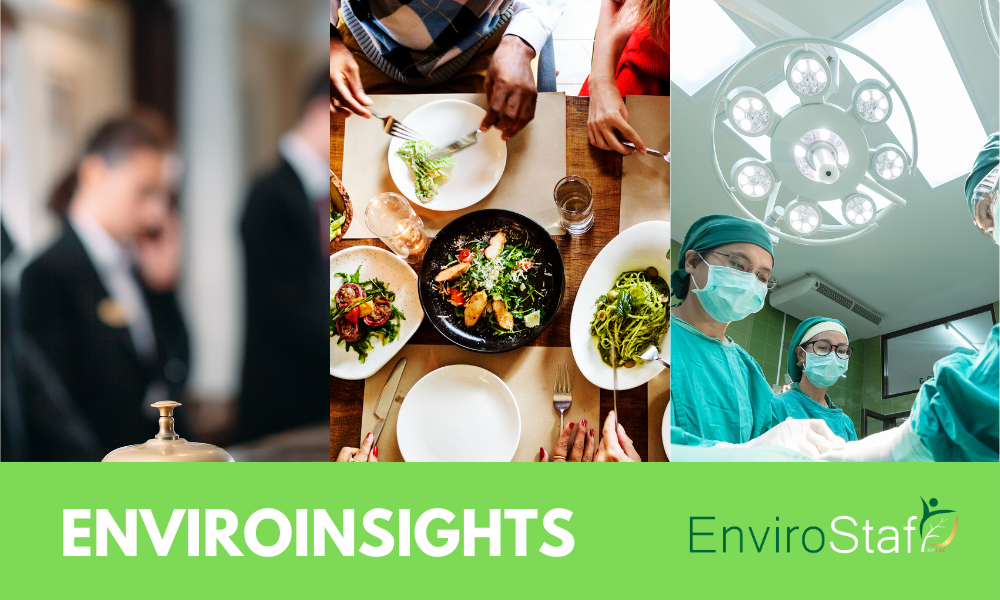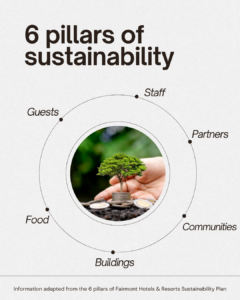Sustainability Success Stories
81% of global consumers think that companies should play a part in helping the environment. So how do you do that?
When you think of sustainability initiatives you might not think about the hospitality industry. Nonetheless, there are very tangible ways that hospitals, schools, hotels, and restaurants can make a commitment to sustainability and see it through.
In fact, it’s already been done. For the last week of this EnviroInsights blog series, we are going to perform a case study of sorts, to see what has already been done well in the industry and what you can learn from it.
Fairmont Hotels
The hotel sector of the hospitality industry accounts for around 1% of global carbon emissions. This might not sound like a lot, but based on the data from 2023, this amounts to around 37,400,000 tonnes of carbon emissions. So, how do you go about reducing that amount in the hotel industry?
Take Fairmont Hotels, who has been an environmental leader for over 30 years. They quite literally wrote the book on sustainability for the hotel sector and continue to pave the way for other hotels to follow suit. Let’s take a page out of their strategy and zoom in on how they did it.
Beginning with a clear strategy and goals, their 6 pillars target their guests, staff, partners, communities, buildings, and food. These 6 areas of work allow them to hone their goals for each target group. From there, they established 4 environmental goals to tailor each target group’s outcome to:
- Reduce energy levels
- Reduce water usage
- Reduce amount of waste
- Reduce greenhouse gas emissions
With these 4 goals, they are able to tackle some of the largest issues concerning pollution and climate change worldwide.
Some of their most notable initiatives include:
- Le Chateau Montebello: Shutting off all non-essential lights in the entire hotel minus the lobby which were powered by a spin class in the hotel. It allowed for a fun night under the stars for hotel guests.
- Jasper Park Lodge: Cooking oil and kitchen grease was converted into biodiesel
- The Savoy: Zero waste program was successfully initiated through recycling food waste into fertilizer and renewable energy
Aside from these individual hotel initiatives, in one of the most creative biodiversity movements, Fairmont launched the Bee Sustainable Project. Like its name, it established more than 40 hotels and apiaries for bees around the world. While bees aren’t the cutest or cuddliest wildlife on the planet, we wouldn’t have natural food or flowers without them. Thus, these honeybee hotels allow bees to take a rest while being protected.
Although the Fairmont chain is not yet carbon neutral, their goal is to reach that benchmark by 2050. As an environmental leader, they’re nearly there and their efforts are promising. Their commitment to sustainability demonstrates that all you have to do is start somewhere. And if you don’t know where to start, check out their guide!
Eden in Chicago
Compared to hotels, the restaurant and food industry is responsible for around 30% of global carbon emissions. Reducing food waste is one of the best ways restaurants can alter their strategies. Take it from Eden, the Chicago-based restaurant who is completely farm-to-table.
For 9 years, Eden has had a special place where they source local farmers’ ingredients. While their pride and joy wasn’t always as big as it was now, their on-site greenhouse is an eco-friendly way they can cultivate their own ingredients.
Eden takes their plants very seriously and only uses organic fertilizer. Their effective composting program starts in the kitchen and cycles through the greenhouse to nourish their ingredients so customers are getting the healthiest farm-to-table experience.
They supply clearly marked compost-specific buckets at every chef’s table to make sure that all compostable ingredients make it into the correct place. Then, partnering with a local composting program, WasteNotCompost, they collect the bins and turn all the scraps into soil.
Running a business and focusing on sustainability at the same time can be a challenge. That’s why they hired an in-house sustainability expert to plan and lead their initiatives so they always stay on track with their goals. If this is an option for you, it’s one worth taking.
Eden loves their greenhouse, but if this isn’t an option for your establishment you can always reduce your waste in other ways. The 2 biggest things that Eden does that you can take note of is:
- Sourcing their ingredients from local farmers
- Donating excess food waste to non-profits
It doesn’t take a greenhouse to offer a farm-to-table option. Plus, donating food surplus or composting are eco-friendly options that aren’t difficult to add into your routine. These changes can reduce your carbon emissions by a significant amount, so take a page out of Eden’s book and try it for yourself!
Kaiser Permanente
One of the most impressive examples of sustainability done right is this California hospital and health care system. Not only did they go completely carbon neutral in just 4 years, they have created an easy to follow guide for other businesses to follow in their footsteps.
Their philosophy as a hospital is “healthy people includes a healthy environment” which informs all of their sustainability decisions. Their strategy was commitment. In 2016 they set goals and by 2020 they achieved them. The result was a drop from 800,000 ton annual footprint to net zero. How did they do it in 4 years?
All of their efforts and processes can be found in their extensive guide for other healthcare systems. The guide is not only applicable for other hospitals, it can be applied to all business systems. Their steps were:
- Gather data from your buildings, suppliers, and employees
- Set public goals that are in line with current climate data
- Reduce energy and switch to clean, renewable energy
- Go green with your transportation
- Transition your electronics to renewable energy options
- Reduce all types of waste
- Serve healthy and locally grown food options
- Involve your staff and community for accountability and to listen to their needs
- Don’t stop once you reach your goal
Kaiser Permanente did in 4 years what other businesses aim to do in 10. If you don’t know where to start going sustainable in your business endeavors, use Kaiser as a model. They show us that going green is an investment in community health and wellbeing.
There is no excuse, and creativity is your greatest business partner. These success stories show us that you need to develop a strategy that works with the mission of your business. Small reductions are still steps in the right direction. So make a sustainable switch now to build a better future for everyone.
Want more EnviroInsights? Check out the rest of our series:
Keep up with all things LGC and EnviroStaff on our socials!
About EnviroStaff
EnviroStaff is a division of LGC that focuses on making placements in the environmental industry. We build partnerships with clients to fill open positions on their team and have recruiting capabilities within multiple markets throughout the U.S. Working closely together, EnviroStaff will recruit environmental industry professionals based on your job description and requirements. By making direct hire placements, EnviroStaff can help clients save time and money often associated with recruiting.







